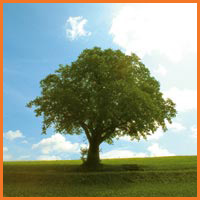The environment
People want a cleaner environment. People also want to save trees. Building with RASTRA is a commitment to the environment for all to see and an example of sustainable living for others to follow.

RASTRA is 85% recycled expanded polystyrene (Styrofoam), would otherwise end up in landfills never to disintegrate. RASTRA buildings reduce energy consumption, and with energy savings comes environmental benefits. Specifically, the reduction of fossil fuels burned to create energy. By reducing energy consumption, we reduce combustion by-products that lead to smog and contribute to global warming. So while your motivation to build with RASTRA may be to reduce energy costs, the end result is that you protect the environment.
Contributes LEED points
![]()
The production of RASTRA is classified as ecologically clean. No particles or fumes are set free during its production. Only a minimum amount of energy is required - producing one RASTRA panel consumes less than 2 kWh of electricity; curing requires no external energy; and no heat is involved in the production process.
All production waste is recycled and converted into new RASTRA product. Remnants from the building site can also be returned to RASTRA and recycled.
Energy Conservation
RASTRA reduces energy consumption, and with energy savings comes environmental benefits. Specifically, the reduction of fossil fuels burned to create energy. By reducing our energy consumption, we reduce combustion by-products that lead to smog and contribute to global warming. The Intergovernmental Panel on Climate Change (IPCC) unveiled its official report on global climate change. This report, produced by 600 representatives from 40 countries, concluded that there is a 90% chance that global warming is caused by the burning of fossil fuels, which emit carbon dioxide.
Forest Depletion
The depletion of forests for building materials has become an issue in many parts of the world. Stunted growth of replanted trees due to acid rain has delayed harvest schedules by as much as three years in most parts of the world, thereby resulting in shortages. According to the National Association of Home Builders, a typical 2,000 square foot home uses 16,000 board feet of lumber plus 6,000 square feet of wood panels. RASTRA greatly reduces timber consumption and reduces toxins caused by wood preservatives to leach in to a new home. An average framed home consumes an average 2.3 acres of forest. Why is it important to save trees? Because mature trees absorb carbon dioxide, a major contributor to global warming.

Would you build your house from wood if you had to use the trees from your own yard?
Reducing CO2 Emissions
The Environmental Protection Agency (EPA) estimates that the average U.S. home releases 22,000 lbs of carbon dioxide (CO2) into the atmosphere each year. That’s twice the amount of the average vehicle. By reducing the amount of energy used for heating and cooling, RASTRA significantly reduces CO2 emissions. In fact, a RASTRA built home can reduce enough energy consumption to eliminate 2-3 tons of CO2 emissions from our atmosphere per year when compared to a similar wood frame home. Over the life of a 30-year mortgage, homes built with RASTRA save our atmosphere 60-90 tons of carbon dioxide emissions.
Extended Service Life
Another measure of sustainability is increased service life. Products that last longer make a large impact on our solid landfills. RASTRA provides an almost limitless service life. This saves space in our landfills, reduces the consumption of fossil fuels to transport new and discarded products, saves timber resources and the energy required to produce new products.
Indoor Air Quality
The unique composition of RASTRA enables better control over indoor environmental quality. Because RASTRA does not hold or wick water the way concrete block or wood products do, RASTRA will not promote or sustain mold and mildew. The composition of RASTRA allows a slow interchange of air, which in turn allows the building to "breathe." The exchange is slow enough that it does not allow heat or cold to escape but helps maintain good air quality, preventing "sick building syndrome." This slow exchange of air prevents condensation that can lead to mold growth. Replacing wood with RASTRA also reduces preservatives that can leach into the interior space.
















